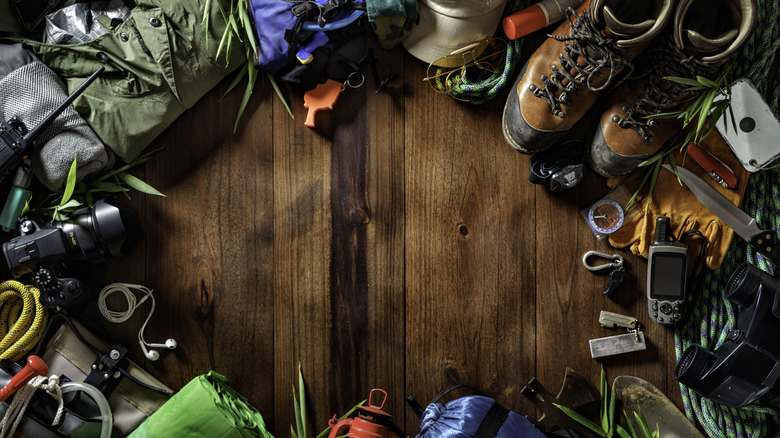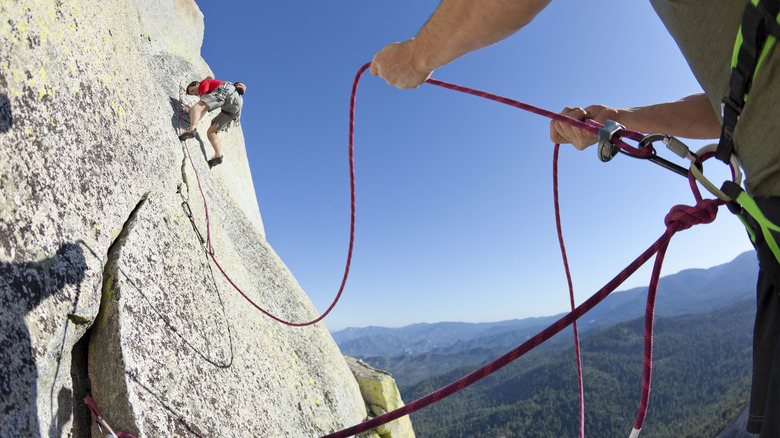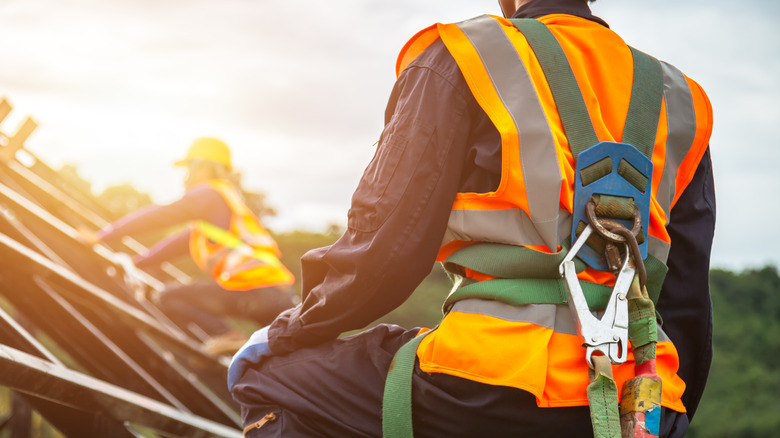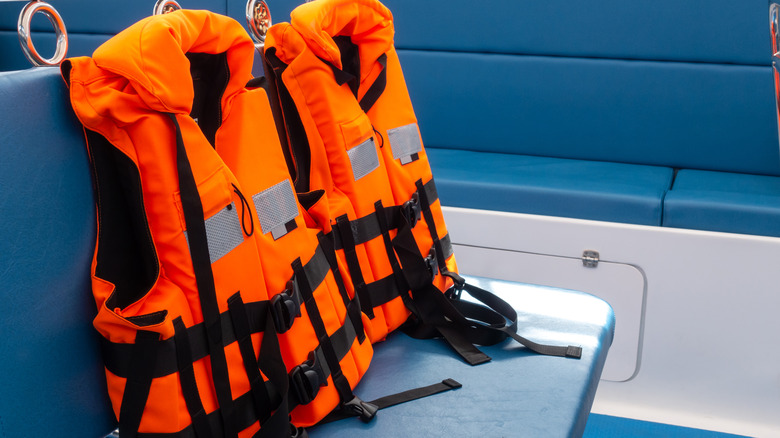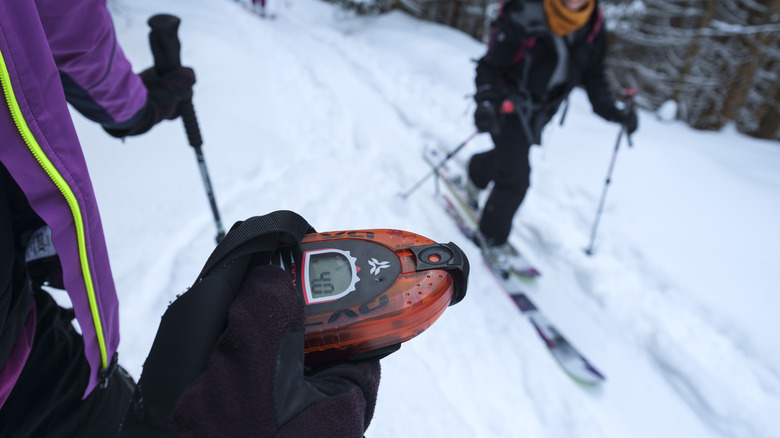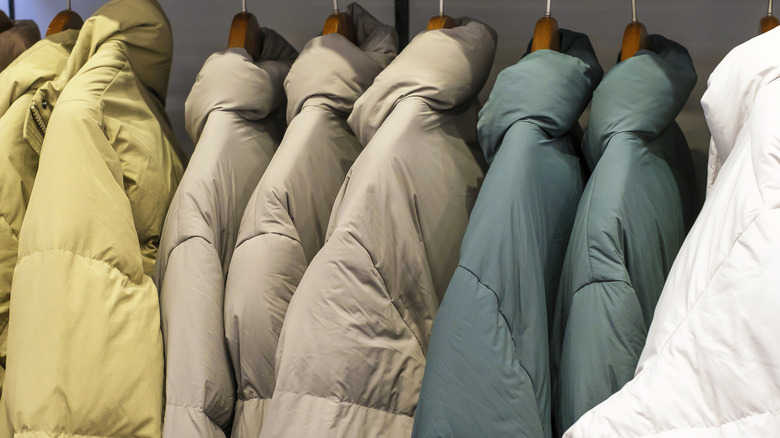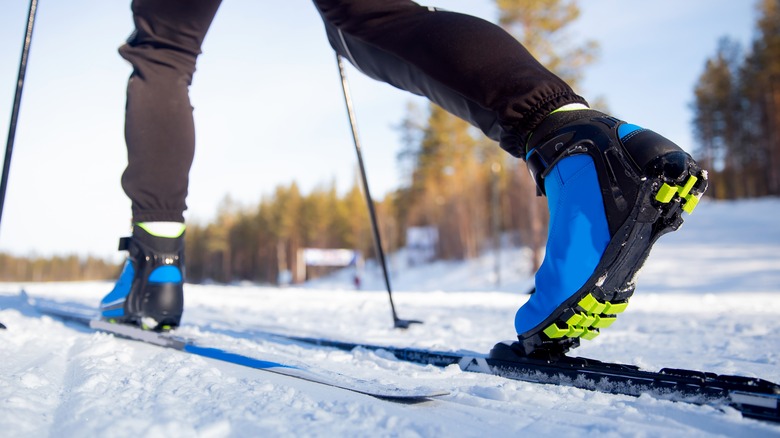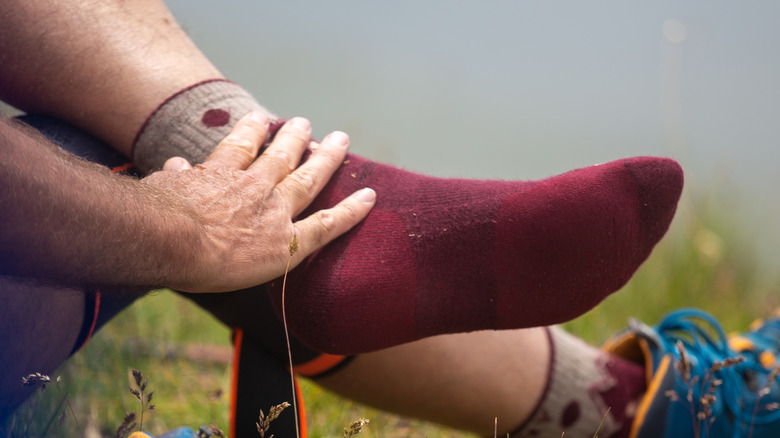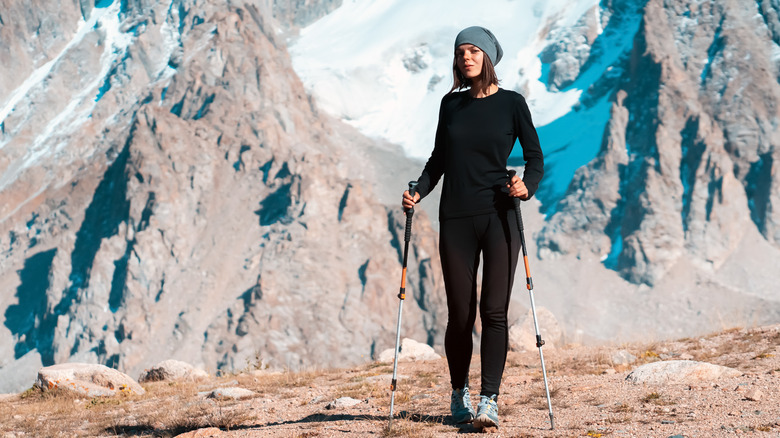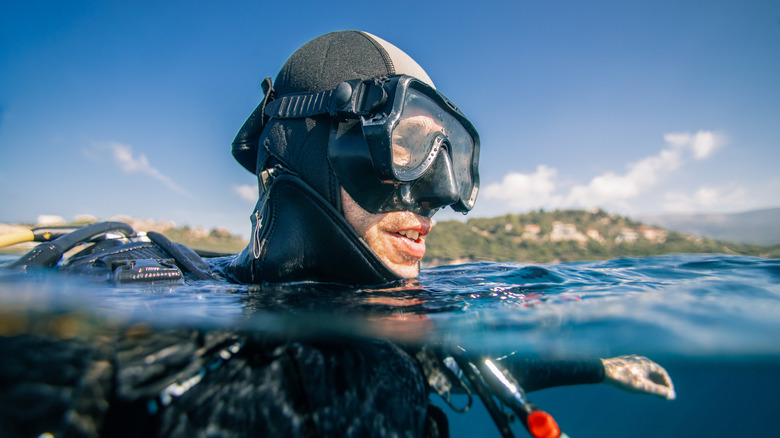Outdoor Gear You Should Never Buy Used, According To Experts
While there is a lot to be said about the environmental and financial benefits of buying used outdoor gear, there are nevertheless reasons to be cautious. It is true that buying used prevents a lot of waste, and allows people with tighter budgets to enter into the outdoor sporting world without needing to spend a small fortune. Still, for all the good of purchasing used gear, there is certain equipment that you should always buy new.
There is a general rule that governs the purchase of new equipment: if the purpose of the gear is to save your life, buy it new. Stuff like clothing, tents, or even sleeping bags are fine used. But harnesses, helmets, lifejackets, and anything whose job it is to prevent injury or death while participating in an outdoor activity needs to be bought new purely because it hasn't been used. Used and abused gear can very often hide the kinds of wear and tear that new gear just does not have unless it's defective.
The items on this list have been compiled using information gathered from experts in their respective sports, as well as our own experiences. Safety items aside, there is other equipment you should purchase and use simply for your own personal benefit, as well as your health. These recommendations are meant to guide you toward purchasing the correct new equipment. Because putting your safety at risk is never worth saving a few dollars.
Helmets
Helmets have wide usage throughout several sports, including, but not limited to, football, cycling, climbing, horseback riding, skiing, snowboarding, hockey, and baseball. While each requires a different type of helmet to get the job done, you never want to buy one used for any of them. Here's why.
Though a brand-new helmet, depending on the maker, can be rather expensive, it is always worth the cost. According to Rerouted, helmets have the ability to hide damage incredibly well. Considering that the helmet's main job is to disperse dramatic force over a large area, having one that has hidden fractures, loose filling, or faulty straps is a major safety concern. Helmets will see a lot of abuse over their short lifespans, so buying one used would not be considered a wise purchase.
There are certain sports that won't even allow you to purchase used helmets. Climbing is a perfect example of this. Most shops will not sell anything but new helmets specifically because of the safety concern. You can always buy one from an independent party, but experienced climbers would advise against it. The climbing helmet is designed to protect you from head impacts with rocks and other hard objects. Keep in mind that damage to your head will affect the entire body. So, when it comes to protecting it, play it safe and buy a new helmet.
Rope
The rope is a fundamental part of the rock climbing process. It forms the basis of the belay, which is a technique where the climber is anchored to the earth by a secondary rope, the slack of which is controlled by another climber stationed on the ground. This makes rope a key safety tool, one that has saved more lives than it hasn't. This is exactly why you should never purchase or use used rope when you're participating in this sport.
Most climbing rope is fabric-based. As a result, it will wear over time with continued use, the same way a sweater or pair of jeans might fray. Obviously, different fabrics have different strengths, so some might take longer to fray than others. Here's where things get tricky. Owing to the fact that rope is so strong on principle, one could be led to think that purchasing used is completely safe. This is poor reasoning.
While most climbers won't even begin to use their rope to the point where it is frayed to the point of breaking, there are still other factors to consider. As Rerouted notes, even rope that hasn't been used could be damaged by UV exposure or lack of use. If you're taking this advice idly, imagine climbing and suddenly both your used anchoring rope and belay rope snap because of poor integrity. That's a situation that can put you in very serious danger.
Harnesses
A harness is another vital piece of climbing safety equipment. Essentially a strong fabric exoskeleton that fits around your mid and upper body, a harness is attached to metal carabiners and ropes that serve as anchors. The harness is your last line of defense when it comes to keeping safe on the rock wall or cliff face. Understand that if it breaks, there is nothing to stop you from careening towards the ground.
The unfortunate thing is that harnesses, like helmets, can hide damage rather well. You might not always be able to tell immediately whether or not the webbing is frayed, the seams are loose, or if there is UV damage. That takes close examination that not many buyers looking for discount gear might not care to look for.
Now, these are things that could be the result of excessive use, or even no use at all. Like a car that is never driven, gear that is never used can begin to fall apart. Fabric-based harnesses have about a 5 to 7-year lifespan, according to Gym to Crag, and can begin to lose their strength with no use. The sun is a particular enemy, as the damage caused by its rays will cause the fabric to change color, and weaken it to certain degrees. So, that's another thing to take into consideration when thinking about buying used equipment. Even if it's barely been used, it could still be hiding potentially dangerous damage.
Life jackets
Life jackets are a point of contention with many people, especially those who feel that they are strong swimmers. Sure, you had to wear one when you were a kid and you didn't know what you were doing, but wearing one as an adult? Yes, actually. Life jackets are life savers in virtually any type of water situation. In fact, the United States Coast Guard believes that 80% of all boating-related fatalities could have been saved with life jackets, per UL Solutions. So why would you risk buying a used one?
As we've already seen with climbing gear, hidden damages could mean the difference between life and death. Nowhere is this truer than with life jackets. Regardless of how strong a swimmer you are, eventually, you will tire. A life jacket is going to be vital in helping you keep your head above water.
As most life jackets are made of foam, they have the ability to wear down and cause the jackets to lose their buoyancy, which is what is going to keep you afloat. When it comes to inflatable life jackets, there could be unseen issues that can prevent the bladders from inflating properly. Because you can never be sure of the history or condition of a used life jacket, and because they are relatively affordable, Life Jacket Safety recommends buying new to avoid the potential danger of a life jacket that is defective.
Avalanche safety equipment
Avalanche safety gear is specialized equipment that is made for one purpose: to keep you alive in the event of an avalanche. These literal tsunamis of snow can engulf you at a moment's notice. According to the National Weather Service, avalanches claim an average of 150 lives a year. They can happen without much warning, and you'd be lucky to escape one. Which is why you should have working safety equipment.
Avalanche safety equipment is vital for any winter hiker, snowshoer, or skier. Common equipment includes things like safety beacons, shovels, poles, and airbag systems that can deploy and decrease your burial depth. Damage to any one of these systems could potentially cause more danger than they would if brand new and functional. This is especially true with avalanche beacons.
Avalanche beacons, also known as transceivers, come with a hefty price tag. What you're buying is essentially a lifeline. It helps rescue services pinpoint your location of burial beneath the snow, and will give them ample time to save you. According to the Vancouver Sun, new beacons are almost always digital, meaning that many used ones, while cheaper, are out of date and incompatible with newer frequencies. And while obsolete gear might be more affordable, you'll be kicking yourself if it doesn't end up working when it matters most.
Down jackets
Moving on to equipment that isn't going to kill you if it goes wrong, we have down jackets. Down is the fine underlayer of feathers found beneath the rougher exterior feathers of waterfowl birds like ducks and geese. It is a highly sought-after material for its insulating capabilities, creating some of the warmest winter jackets available on the market. And while these jackets do come with an eyebrow-raising price tag, you might want to hold off buying a used one until you've read what we have to say.
The thing about down is that, while it is amazing at what it does, it can be rather finicky to maintain. Cleaning a down jacket is an intensive affair. If it is done one too many times, you run the risk of losing exactly what makes the down jacket so special in the first place.
Unlike fleece, which does not lose its insulating quality, down jackets that have either lost their feathers or have been worn out with excessive use will lose their insulating capabilities. So, unless you are purchasing from a trusted source, Outside recommends buying down jackets brand new. It may burn a temporary hole in your wallet, but you are going to get much more bang for your buck in return because the lifespan of the jacket is going to be longer, and you are guaranteed proper insulation.
Hiking backpacks
Having the right hiking backpack is a matter of preference as well as safety. There are two kinds of hiking packs — backpacks and day packs. The latter is sort of like the outdoor version of your average school pack. It's on the smaller side and designed to fit the essentials for a day's hiking. These can be purchased and used without cause for concern. Backpacking backpacks, however, are a different animal.
According to Outward Bound, you want to buy these types of packs new purely because they are going to be specifically fit to your body type. Backpacks designed for longer, multi-day hikes are made to be as ergonomic as possible. They need to fit you properly. Otherwise, they are going to become a burden on your muscles, which is the exact reason why you want to shy away from buying a used one.
A used backpack is going to fit someone else's size, not yours. Unless you get extremely lucky and find a used pack that fits your exact dimensions, you're going to end up having some trouble. Chief among these is how the weight of the backpack is distributed. If it can't be distributed evenly, like a properly fit backpack would be, you run the risk of muscle strain, which could lead to earlier exhaustion, over-exertion, and even injury. You're only doing yourself a favor by buying a new backpack, and your muscles will thank you for it.
Hiking/ski boots
Like with backpacks, the stuff you put on your feet should fit you properly. When you're buying used hiking or skiing boots, you run the risk of purchasing something that potentially won't fit you properly. Unlike a new pair of boots, which you can break in over time, a used boot is already broken into someone else's foot structure. As a result, they are not going to fit your feet the way that a new pair would. There is also the element of wear and tear.
This is more of an issue with skiing boots than hiking boots. According to Outside, ski boots need to click in and be attached to the skis themselves. The soles can't be worn, and the buckles and snaps all need to be in order so that the fit is secure. So, unless you are prepared to take them to a pro shop to be fixed up, you should really consider buying new.
And it is not as if used hiking shoes are without fault. In my own experience, the tread on a hiking boot is never better than when it is new. Because you're walking over rough surfaces, the potential for wear is only going to increase with use. So, any used boot is not going to give you the traction you need unless it's barely been used. In which case yes, it would be okay to put a new pair of laces on it and buy it for cheap.
Hats
Buying used hats is a little bit different than stealing your grandpa's fedora as a child. Chances are, grandpa never wore that hat for days on end, sweating profusely into the rim and getting it dirtier than it had any right to be. That is unless your grandpa was Indiana Jones, but we digress. Owing to their incredibly close proximity to your head, hats are one thing you should be extremely wary of buying used. In fact, Outward Bound recommends wholeheartedly that you buy them brand new.
Hats can be host to all sorts of potentially nasty things. The chief culprit, in this case, is head lice. Helmets are prone to this too. Head lice are those nasty little critters that multiply and spread like wildfire. If someone has been exposed to head lice in the past, buying their used hat, which could contain the eggs of the head lice, could very easily spread to you. Apart from being downright annoying, they can carry infections with them, which is never good news.
This applies to all types of hats, but especially baseball caps and beanies since they will be the most likely to be used when out on the hiking trail. Though it will take a little time for a new hat to properly fit your head to the point where it is comfortable, the temporary discomfort is worth it to avoid things like lice.
Socks
People are very particular about what they put on their feet. While you would not really blink twice about buying a used shirt or pair of jeans, buying used socks is something most people would never, ever dream of doing. And there is a good reason for that. Much like with hats, socks have the potential to be host to a whole manner of different, gross things that could wreak havoc on your feet.
The icky things lurking within socks are the stuff of many people's nightmares. Unless they are your own, and you know where they've been because they have been on your own feet, you are going to have some issues with socks. Not only can they carry dead skin, but they are also havens for foot funguses. Infecting your feet with a foot fungus is a very real problem with used socks, especially when you're backpacking and don't have access to the right treatment. These outcomes could be avoided if you just bought new socks, as Outward Bound recommends.
However, this does depend on the fabric the socks are made of. Some, like wool, are incredible for their cleaning and moisture-wicking properties. Others, like polyester, while stretch and comfortable, will hold onto a whole host of different things, even if they are cleaned.
Base layers
It may seem as though we are kicking a dead horse here, but do you really want to be buying used intimates? While we might think more lingerie style when we think about underwear, base layers are just as intimate. Essentially the fancy term for long underwear, base layers are utilized for those engaged in wintertime outdoor activities. They are used, abused, and sweated in. They are also in contact with the more unmentionable areas of your body. For that reason alone, they ought to be purchased new.
Like socks, a lot depends on what the base layers are made of. Wool base layers are going to be your best bet if you absolutely have to buy used base layers. Wool won't hold onto odors and moisture, unlike polyester and other synthetic fabrics which, Outward Bound notes, can hold onto odors and other nasty things, even if washed thoroughly.
Scuba gear
Finally, we have scuba gear. I'm going to use my own experience with scuba gear to give you an idea of why you should buy used. My parents were both scuba divers, and my dad was actually a certified rescue diver. I grew up around the equipment, and have an excellent idea of its ins and outs.
Wetsuits are fairly common to be found and worn. You still want to be careful about buying one because, depending on age and use, it could be in varying states of shape. However, more important than the wetsuits are the more technical components of scuba diving gear. Things like oxygen tanks, regulators, respirators, and the like should always be bought new just in order to ensure that there are no technical deficiencies due to lack of maintenance. Seeing as they do most of the work of keeping you alive, you'll want to make sure they are in the best condition when you buy them. The last thing you need is something going wrong when you're deep underwater.
We hope that this has given you a decent idea of the kinds of equipment you want to spend your money on. Whether you're protecting your life by purchasing a new helmet, ensuring your jacket is warm, keeping funguses off your feet, or getting a backpack with the right fit, there are certain things you should splurge on.
